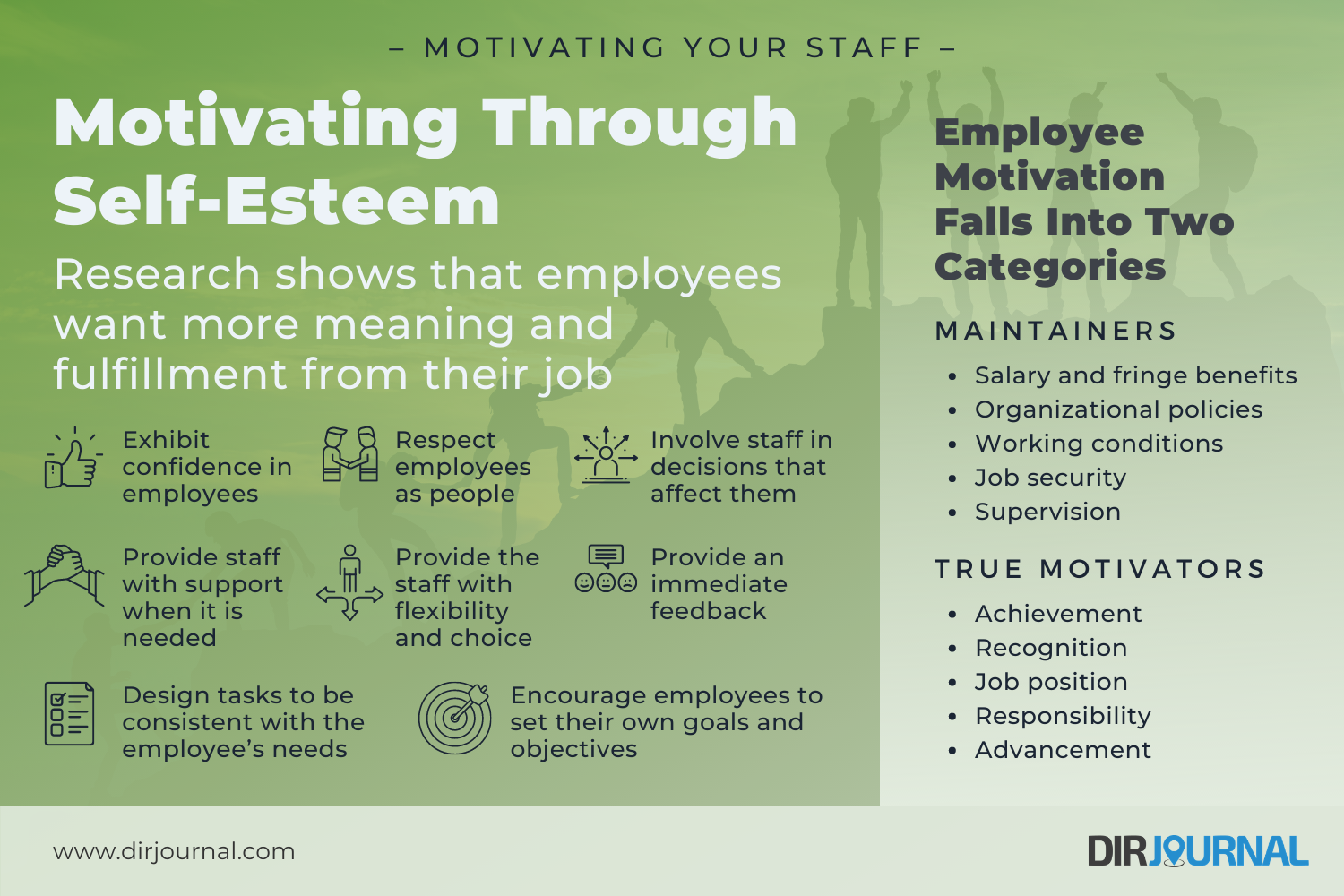Motivation is one of the primary concerns and challenges facing today’s supervisors and managers. This article will introduce you to techniques for creating a proper motivational climate. You will also learn how to apply these techniques for motivating your staff, prepare individual action plans to solve on-the-job problems, and identify causes of low morale and strategies for improving overall employee behavior.
Your staff members are the key to your success: Motivation is key to employee performance, and thus ultimately affects all departmental, divisional and organizational objectives. Only satisfied employees lead to satisfied customers.
Keys to Understanding Motivation
To be a successful manager or supervisor, you must first understand that you cannot truly motivate anyone.
What you can do is create an environment that encourages and promotes the employees’ self-motivation. Motivation is getting people to do what you want them to do because they want to do it. The challenge is to give them a fitting reason to want to do this. Doing it must satisfy a need they have. You have to tune in to their needs, motives and reasons, not yours.
But you must also be clear about your objectives and expectations yourself before you can communicate them to your staff. You need to know what kind of behavior you want your staff to demonstrate. In other words, what exactly do you want an employee to do differently? For example, do you want your staff to be punctual? More committed to work? Coordinate with others in a friendly manner? Meet deadlines? Assume more responsibilities?
That said, there is rarely a quick fix to a behavior problem. Changing employee attitudes takes time and patience. You will notice that what works well for one person may not work for another one. You may have to go through ‘trial and error’ until you identify and match the right method, or a combination of methods, to the relevant employee.
Why You Can’t ‘Just Motivate’ Someone
Can you motivate someone? The answer is a clear no. Motivation is something that comes from within individuals to prompt them to specific action. Motivation is a function of individual will. We mostly do things because the outcome is appealing to us and serves as an incentive. More rarely, we find certain tasks rewarding in themselves.
People are motivated by their unmet needs, and those needs differ from person to person. People’s needs are determined by their unique set of circumstances, culture, values, background, education, work experience and their personality styles.
Besides these individual factors, motivation is also directly related to the morale of the employees. This means that the attitude of the whole staff toward their work, department, environment, management – including you – and the organization as a whole also affects every single employee’s motivation.
You are a Crucial Part of Staff Motivation
The most important thing to keep in mind is that you are a critical component in the motivation process. Your actions set the tone, trend and tempo of any process of change – and determine its effectiveness.
Many managers and supervisors embrace the ‘carrot-and-stick’ approach to try and motivate their staff. Some focus on ‘carrot’ practices, which can come in the form of incentive programs, promises of promotions, rewards and bonuses. Others employ the symbolic ‘stick’ by emphasizing the negative consequences of staff behavior. For example, a manager might say: ‘If you don’t start coming to work on time, you’ll be fired,’ or use put-downs like ‘You will never get ahead if you keep making these kinds of mistakes’.
The weakness of all these methods is that any effects they have are short-term – they don’t create true behavior changes. Or at least not the ones you’re aiming for. ‘Stick’ tactics, in particular, tend to drive up resentment in the long term, rather than motivation.
Executives whose management style is dictatorial, non-communicative, and non-participative need to revise their work style. Today’s business environment requires more empathy, communication, and trust in employees. They will only make a difference if they can make subordinates feel important and successful.
Managers need to create a positive and caring workplace that encourages employees to become the best they can be. When staff feels good about themselves, they will perform better and be more productive.
Assessing Your Approach
You may find yourself puzzled by a certain employee’s apparent lack of motivation. You pay a decent salary and don’t understand why this person is not performing well. The first step to real understanding is to accept the fact that what motivates you may or may not be effective in motivating your staff. Then, you need to reflect on your approach.
Begin by taking a moment and prioritizing the following 12 motivating factors according to their importance to you:
- Job security
- Good salary
- Fringe benefits
- Pleasant working environment
- Interesting and challenging work
- Recognition for doing a good job
- Cooperation of the people I work with
- Feeling of personal accomplishment
- Participation in decisions that affect me
- Opportunities for promotion and growth
- Clear understanding of what is expected of me
- Loyalty and fairness of my manager/supervisor
Now go back over the same list and identify the order you think this or that particular subordinate would choose.
Rethinking Priorities
Here is why trying to put yourself in your team member’s shoes is so important: Research proves that executives are often totally wrong in predicting how their subordinates would rank the list.
The result? Managers will choose methods of motivation that are entirely off-base. For example, a manager may believe that all employees are motivated primarily by money. So, the manager promises everyone a bonus. Much to his surprise, employee performance does not improve. What this manager does not realize here is that there may be other factors that are more important to the employees.
So, how do you find out what motivates your subordinates? Well, you could ask them to complete the above assessment as a start, although you may not get accurate data. The best way is to talk to your staff and really listen to them. They will let you know indirectly or sometimes even directly what is important to them.
For example, you might have an employee who frequently asks you, ‘How am I doing?’ or ‘Did you like the way I handled that project?’ This strongly indicates that that particular employee wants and needs recognition.
Identifying Your Managerial/Supervisory Role
At this stage, a crucial question might be vibrating in your mind: As a supervisor/manager, what is my role in the motivation process? The answer: Your responsibility in motivating your staff is to create an environment that promotes motivation within the individuals.
Good leadership is getting people to do what you want them to do because they want to do it. So, you must first understand employees’ needs and then show them the benefits of moving them from where they are to where you want them to be. In other words, find out the WIIFT: What’s In It For Them.
Times have changed and so have employees. What worked ten or fifteen years ago is no longer appropriate for today’s employees. In order to be effective in creating a positive motivational climate, we need to take a look at what characterizes today’s employees. The following points are the hallmark characteristic of contemporary employees:
- Desire for developmental opportunities
- Want work to be challenging, interesting, and creative
- Want to participate in all decisions that affect them
- See remuneration as the outcome of their performance and, consequently, expect to be rewarded accordingly
- More concerned with organizational recognition than their recognition at the managerial/supervisory level
- Expect and appreciate communication from management and opportunities to communicate to management
Take a moment and think about the implications of these characteristics on the workplace and your responsibilities in motivating your staff.
Maintainers and Motivators
Research shows that employee motivation factors fall into two categories: maintainers and motivators. Maintainers are factors that must be kept at a satisfactory level. They include:
- Salary and fringe benefits
- Organizational policies
- Working conditions
- Job security
- Supervision
True motivators are factors that create an inner desire to work by satisfying certain needs that are important to the individual employee. They include:
- Achievement
- Recognition
- Job position
- Responsibility
- Advancement
As an enterprising supervisor/manager, take a few moment and analyze your department or organization based on how you can cater to the two above categories.
Are your maintainers really satisfactory? Are you providing the kind of reward that employees really desire? And: Are you using the same approach for everyone, or do you personalize it?
What Motivates Your Employees?
Do you know what your employees really want?
A good way to find out is to simply ask them. Their answers could surprise you. Talk to your staff members – or run an anonymous survey. You might find out that what you think employees want and what they really want are seriously at odds.
Rank the following most common motivators in terms of how effective they would be for motivating you and your employees:
| Motivator | Your Ranking | Employees’ Ranking |
|---|---|---|
| Money | ….. | ….. |
| Job Security | ….. | ….. |
| Fringe Benefits | ….. | ….. |
| Promotion | ….. | ….. |
| Self-improvement | ….. | ….. |
| Working Conditions | ….. | ….. |
| Interesting Work | ….. | ….. |
| Recognition | ….. | ….. |
| Appreciation | ….. | ….. |
| Feeling Informed | ….. | ….. |
Your response to this list will likely highlight the fact that you, as a manager or supervisor, consistently see yourself as being motivated by different factors than your subordinates.
It’s fairly likely that you feel that the best ways to motivate employees are the traditional trio of motivators: job security, financial rewards, and promotion.
But these traditional motivators are scarce resources for the manager/supervisor – they cannot be provided by every organization, or to every employee, under today’s working conditions. If these are a manager’s primary means of motivation, the majority of the employees can’t but remain unsatisfied even by the manager’s own standards.
For a motivational strategy to work, you must have more to offer than this classical trio. As an exercise, select two employees and try to determine what motivates each of them – and their differences. Then, identify what you could do to meet each person’s individual needs.
Motivating Your Staff With Their Own Desires
Research shows that employees do want to make a difference at work. Increasingly, they want more meaning and fulfillment from their job. A manager or supervisor motivates staff members by getting them involved and committed to the tasks that need to be done, not by forcing them. You can use the natural desire of people to make a difference at work and mould it into focused activity.
To help you with this, you can apply the following time-tested formula for motivating people: VIP – Validation, Information, Participation. Here’s a quick break-down:
Validation
- Respect for employees as people
- Flexibility to meet their personal needs
- Encouragement of learning, growth and skills
Information
- Knowing why things are being done
- Getting inside information about the organization
Participation
- Involvement in decisions that affect them
- Employees having control over how they do their work
Think about how you can utilize these three elements in the following list of techniques.
Modern Techniques for Motivating Your Staff
In order to become an effective supervisor/manager, use the following techniques to create an environment that excites staff members to work.
However, you must design tasks and environments to be consistent with the employee’s needs. What may satisfy one employee may not satisfy another. The observant supervisor/manager is well aware of the basic needs of the employee, such as affiliation, approval, and achievement.
1 – Use appropriate methods of reinforcement
Rewards should be tied directly to an individual’s performance. If you have determined that meeting deadlines is important, then the employee’s performance in rendering that service should be rewarded. In this case, an employee who goes the extra mile to complete a project on time should be acknowledged and rewarded accordingly.
However, keep in mind that reinforcement is personal. What reinforces behavior in one person may not reinforce it in another one. It is also important to dispense reinforcement as soon as possible after the desired performance.
Think of a recent incident when one of your employees went above and beyond the call of duty. Did you reward them in some way? If not, what could you have done to reinforce the behavior you want repeated?
2 – Provide your staff with flexibility and choices
Whenever possible, give employees a chance to make decisions, particularly when they affect them in some way. Choice results in personal commitment, which is a core component of motivation. People who are not given the opportunity to choose for themselves tend to become passive and lethargic.
For example, you might be thinking of rotating the employees’ work. A way to deliver choice and flexibility to your staff is to give them the parameters and then allow them to rotate themselves.
3 – Provide staff with support when it is needed
One key characteristic of achievement-oriented staff is a willingness to use help when they need it. Employees should be encouraged to ask for support and assistance – and you’ll need to deliver on it. Otherwise, they will become frustrated. Asking for help should never be considered a sign of weakness, rather, it should be considered a sign of strength.
And you will need to demonstrate this learning-oriented attitude to truly motivate staff.
When an employee comes to you for help, be careful not to turn them away with comments such as ‘You still don’t know how to do that? I already explained it to you.’ Instead, ask: ‘Tell me where you are having problems. How can I help you?’
4 – Encourage employees to set their own goals and objectives
Let your staff participate actively in the goal-setting process. People tend to know their own capabilities and limitations better than those of others. Besides, personal goal-setting results in a commitment to goal accomplishment.
For example, in setting a production goal, ask your staff to come up with a realistic monthly goal and a plan to reach that number. Then you should sit down and evaluate the goal by applying the following criteria:
- Is the goal specific? Write the goal in such a way that everyone can identify exactly what you plan to accomplish.
- Can you measure it? Identify the deliverable.
- Is it agreed upon? All those involved must agree. In most cases, this means the manager and the employee or employees who make it happen.
- Do you have the resources? Make sure that you have all the appropriate resources – time, skill, equipment, environment, funds – to successfully reach the goal.
- Are there time boundaries? Set deadlines, interim reviews, and target completion dates.
Think of an employee you would like to involve in the goal-setting process. Then, outline how you are going to approach them. How can you communicate the reasons you are asking the employee to set their own goals? Are there any guidelines or parameters they should consider?
5 – Relate employees’ tasks to personal and organizational goals
Routine work can result in passivity and boredom unless employees are aware of how these routine tasks contribute to their own development and the success of the organization. Point out how their task fits into the big picture. A few extra minutes to explain this can increase productivity tremendously by motivating your staff through a sense of purpose.
Exercise: Think about a task one of your employees does routinely. Ask yourself: “Why are we doing this?” Now, 0utline a plan to explain how this task ties into organizational goals.
6 – Clarify your expectations
Make sure that employees understand what you want from them. Regardless of the size of your organization, you should have a job description for every position, clearly outlining qualifications and responsibilities.
Also identify the expected standards of performance. For example, if you expect a secretary to answer phone calls within three rings, say so. Employees are not mind-readers. You cannot assume that just because they have experience in doing the job, they know what you specifically expect of them in that position. Their previous employer may have had rather different standards.
Identify a position in your department/organization and write a job description for it. If you already have written job descriptions, choose one and review it to make sure it is clear and includes specific standards of performance.
7 – Have a flexible management style
Many supervisors and managers pride themselves on treating everyone the same – dangerously misunderstanding what ‘the same’ means here.
You do need to treat everyone fairly – but not necessarily behave the same towards everyone. Employees are, after all, individuals with individual needs, and you miss out on potential to motivate your staff if you do not recognize this.
A flexible management style also means that you adapt your approach not only to the individual but also to the situation. An employee new to the job will need more guidance than a five-year veteran. And: If you’re delegating a new task or responsibility to that senior employee, that person may still need additional guidance in that particular situation.
Think about how you would characterize your supervisory/managerial style. Do you use the same approach in every situation? Think about situations or employees that could benefit from you modifying your style accordingly.
8 – Provide immediate, constructive feedback
Feedback is most effective when it quickly follows performance. Feedback should also be relevant to the task and should indicate to employees how they might go about a task differently. This will help staff actually improve their performance in the future.
Keep in mind, too, that feedback should be both positive and negative. Employees often complain that the only time they receive feedback is when they do something wrong. Notice people doing something right and tell them about it.
To be constructive, feedback also must be specific. Above all, never give negative feedback without information. The same applies to positive feedback: Just generally telling staff that they are doing a good job and to ‘keep up the good work’ is nice as a gesture, but does not consitute helpful feedback.
It is much more effective and meaningful to say something like this: ‘Ahmed, I appreciate the way you handled that challenging project. You really showed a great deal of professionalism by meeting the deadline.’
Identify a recent event in which an staff member did something outstanding. What, if anything, did you say about the employee’s performance? Would you say it differently now?
9 – Identify and help eliminate barriers to individual achievement
Some staff members who are labeled ‘failures’ or ‘incompetent’ are simply being hindered by relatively minor obstacles that their managers or supervisors have not recognized. Eventually, this may lead the employee to accept the failure label as a fact, destroying any remaining motivation.
Does the employee have the knowledge and skills they need to properly do their job? If not, it is your responsibility to provide them with the required training. Does the person have the appropriate tools or technology? If not, get it. Make sure employees have the training, information, tools and right equipments to do the job.
Identify an employee who does not seem to be as motivated as you would like. Ask yourself if there is a barrier that perhaps you have not previously considered.
10 – Demonstrate confidence in employees
There is a great deal of research to support the contention that people who are expected to achieve will do so more frequently than others. It’s not enough to have that expectation – you also need to actually show it in your interactions.
Consider the difference between telling an employee, ‘I know this new procedure may be uncomfortable and may be even difficult for you at first, but I know you will be able to make the adjustment’ and, ‘Give it a try. If you can’t handle it, we’ll see what we can do about it’. The latter statement conveys the subtle message that you expect the person to fail – even if you actually don’t. For that reason, the former statement is more effective: It implies that you expect them to succeed.
The concept of the ‘self-fulfilling prophecy’ is very powerful. Managers or supervisors who are positive create high performance expectations. They encourage employees to ask more questions; allow more time to do a job correctly and give their employees the benefit of the doubt.
Identify ways in which you can demonstrate confidence in your employees.
11 – Establish a climate of trust and open communication
Productivity is highest in organizations that encourage openness and trust. Trust and openness result from our communication styles. Do you use phrases that build people and get things started – or ones that destroy ideas and discourage creative thinking ?
Review the following list. Which replies do you use more frequently?
- A great idea, but I’m sure it won’t work.
- We don’t have time for these suggestions.
- We’ve tried that before, it didn’t work well.
- That looks fine on paper, but can you put it in practice?
- You haven’t considered the budget limitations.
- We have too many projects now; let’s discuss it at some other time.
- That would be interesting to try; I’m glad you brought that up.
- Job well done; keep it up!
- You’re on the right track.
- That’s the first time I’ve had anyone think of that.
- I have full confidence in you, and I appreciate what you’ve done.
- I’m sure you can do it!
- I’m very pleased with what you’ve done.
- Go ahead, try it. I can always depend on you.
If you find yourself using any of the negative ‘killer phrases’ or similar ones, reword them to be more encouraging and positive. Not all ideas are doable, obviously, but you need to encourage people to keep them coming.
Be especially careful not to send mixed messages – as in when your verbal and nonverbal actions don’t agree. A manager who says, ‘Carry on, I’m listening to you’ and continues to look through papers communicates that they are not really interested in what the employee says. It’s counterproductive in terms of motivating the staff.
12 – Listen to and deal effectively with employees’ complaints
It is very important to handle problems and complaints before they go out of proportion. In addition, employees feel more significant when their complaints are taken seriously.
Conversely, nothing hurts as much as when others dismiss a personally significant problem as unimportant. Telling an employee ‘It is not a big deal’ or ‘You shouldn’t feel that way’ devalues them.
You may not think that something is all that important, but it is to the employee. Acknowledge complaints and their validity, then solicit the employee’s input to resolve it. This is a core ingredient for motivating your staff. In fact, it’s a vital managerial skill.
Think about a recent employee complaint that you regarded as trivial. How did you actually respond to the employee? Is there anything you should have done or said differently?
13 – Point out all improvement in performance, no matter how small
This is particularly important when employees begin work on a new project. Frequent encouragement is very effective in improving the staff performance and in building a positive attitude. You can reduce this reinforcement as the employees become more confident and proficient, and require it less.
Identify an employee whose performance needs to be improved. Identify how you are going to communicate the desired change, how you are going to monitor the performance, and what you are going to say to offer encouragement.
14 – Demonstrate your own motivation in behavior and attitude
Nothing turns employees off faster than a manager or supervisor who does not practice what they preach. Actions speak louder than words; be a role model. If you expect staff to be on time, then you must make sure you are on time, too.
If you expect employees to treat customers with courtesy and respect, you should treat the employees the same way. Also, when you expect employees to get additional training to upgrade their knowledge and skills, you should also attend seminars and courses to fine-tune your management skills. Motivating your staff is difficult if you don’t go along with your own programs.
Think about any areas where you might not be modeling the appropriate behavior. What can you do differently?
15 – Criticize performance, not personality
Judge behaviors, not the employees. An individual can do a task poorly and still be a valuable employee. Always remember to respect staff. There’s a profusion of valuable adages to prove the point: What goes around, comes around. Love begets love, and respect wins respect. A great manager shows their greatness when they talks to an insignificant employee.
Too many employees are inappropriately labeled lazy, inefficient, incompetent, useless or unqualified over performance at individual tasks. Be sure to address behavior and not personality or attitude for the best chance at motivating your staff. Managers often have difficulty distinguishing between attitude and behavior.
Take, for example, the following statement: ‘Ahmed doesn’t take his work seriously.’ Is that an attitude or behavior statement?
The answer is ‘attitude’.
An attitude is a feeling or emotion about an observed situation, and they are difficult for others to determine. A behavior, on the other hand, is something that can be observed. To state the above example in terms of behavior, you might say: ‘Ahmed’s reports contain errors that require rewriting. He has missed deadlines that affect the delivery of our quarterly project review.’
Think about how you might you rewrite the following statements:
- She is incompetent at filing.
- He is slow at his computer work.
- She is not interested in her job.
- He is rude to colleagues.
Measure Your Success
In order to measure your managerial or supervisory success in motivating your staff, you must first lay out your own action plan – with clear goals and meaningful indicators.
Here’s a very simple scheme for doing so. Select two or three ideas you would like to adopt and then fill out the following:
a) Three things I plan to do differently in my department:
- .……..
- ………
- ………
b) Obstacles I might face along the way and how I will overcome them
- .………
- .………
c) I will know I have succeeded in becoming a more effective manager and motivator of people when
- .………
- .………











